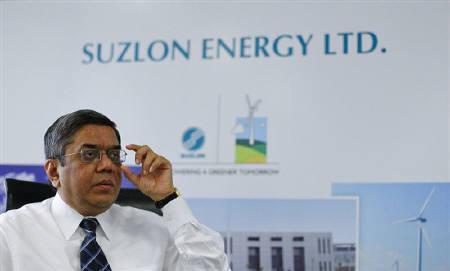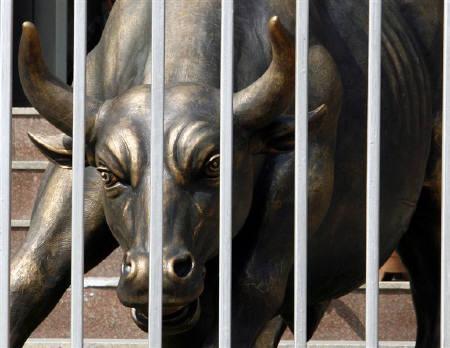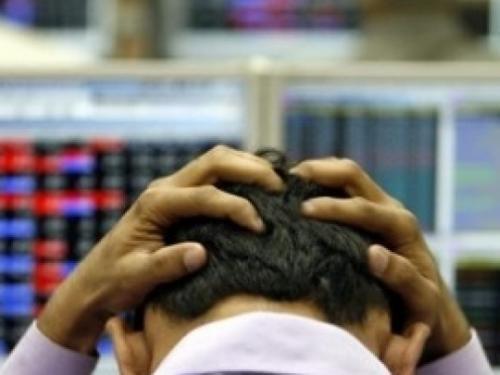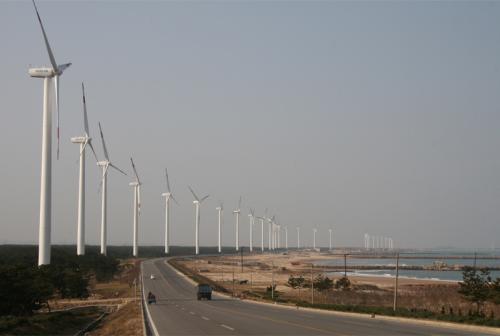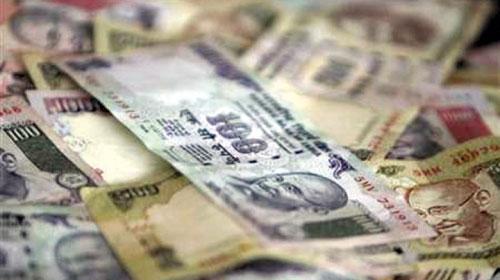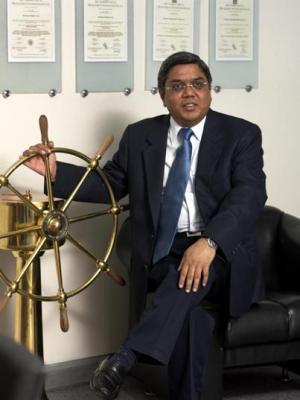 | « Back to article | Print this article |
Can Suzlon ride out the storm?
Last week, Suzlon Energy defaulted on $221 million worth of foreign currency convertible bonds (FCCBs) - the biggest ever default by an Indian company - as bondholders refused to grant four months' extension sought by the company.
The default has raised a question mark over the survival of the beleaguered wind-turbine maker.
Not so long ago, Chairman Tulsi Tanti was a symbol of what India Inc could do in a globalised world. In a little over 10 years, he transformed Suzlon from a three-man start-up to India's wind energy goliath and one of the world's leading wind-turbine makers.
But, as things have unfolded, it is clear that growth can often be a double-edged sword. If the pace is too slow, you are left out; but, if you go too fast, maintaining that pace consumes too much energy and even a small hurdle can trip you. This is exactly what happened to Suzlon Energy.
Click NEXT to read more...
Can Suzlon ride out the storm?
At its top speed, Suzlon was doubling in size every year and, for a whi#8804 it became the best bet on India's booming power sector.
In the five years beginning FY03, Suzlon's consolidated revenues jumped 77 times to touch Rs 27,600 crore (Rs 276 billion) in FY09, growing at a compound annual growth rate (CAGR) of 138.5 per cent.
The gravity-defying growth pushed Suzlon's market value to Rs 68,000 crore (Rs 680 billion) in the first week of January 2008, making Tanti one of India's richest businessmen.
The growth provided him with the firepower to push for more. But, trouble came soon enough. Suzlon's growth model, experts now say, was never financially sustainable and it was growing on the back of easy credit.
The bulk of the company's internal accruals (cash profit) was consumed in working capital, leaving very little to fund growth.
Click NEXT to read more...
Can Suzlon ride out the storm?
In the run-up to the 2008 global financial crisis, the company was spending 40 per cent of its revenues on inventories, loans and advances and customer credit, more than double the rate four years ago.
This was unsustainable, given its operating profit margin of 25 per cent, and the company resorted to borrowings to fill the gap. In the midst of all this, it spent over Rs 10,000 crore (Rs 100 billion), largely funded through debt, to make two back-to-back acquisitions in Europe.
The combined effect was a spike in Suzlon's debt obligation to Rs 15,000 crore (Rs 150 billion) at the end of March 2009, from just Rs 450 crore five years ago (Rs 4.5 billion).
Suzlon stumbled when the credit markets froze after the collapse of Lehman Brothers in September 2008. In FY09, net profit fell 75 per cent despite a 25 per cent increase in revenues, as interest payments zoomed and Suzlon took a hit on forex transactions.
The following year, the company's global revenues fell by 30 per cent and it reported its first net loss in more than 10 years.
The company's share price began to tumble and within months of the Lehman collapse, its market value was a fraction of the debt on its books. It could no longer raise enough equity to retire debt.
Click NEXT to read more...
Can Suzlon ride out the storm?
Things have not improved much since then. Cash profit has been negative in two of the last three years, even as interest obligations continue to mount. What's worse, analysts say, is that there is a slim chance of any immediate improvement in the operating environment.
"The best that the company can do right now is to buy time and wait for the business cycle to improve," says an analyst at a leading brokerage.
But, there is a silver lining. Bankers are still willing to extend a lifeline to the company. They still believe in the business acumen of Tanti and find value in the global wind energy complex built by him in the last decade.
"Tanti is a genuine businessman determined to turn around his company," says a senior executive at State Bank of India (SBI). He compares Tanti with Kingfisher Airlines promoter Vijay Mallya, who "never sounds serious about turning around his airline and repaying the debt".
SBI is Suzlon Energy's lead banker with a total exposure of around Rs 3,500 crore (Rs 35 billion), a quarter of Suzlon's total debt. Bankers have begun to examine the option to take the company to corporate debt restructuring (CDR) to recast its loans.
It could involve a combination of extending the repayment period, a commitment from promoters to infuse additional funds or conversion of a part of debt into equity.
Click NEXT to read more...
Can Suzlon ride out the storm?
Another draw for bankers is the group's strong order book worth nearly Rs 35,000 crore (Rs 350 billion) at the end of the June 2012 quarter and its strong manufacturing footprint spread across India, Europe and North America.
At the end of FY12, Suzlon's cumulative investment in manufacturing assets amounted to nearly Rs 7,500 crore (Rs 75 billion).
Suzlon seems to know this and, thus, has ruled out emergency measures, such as selling its German subsidiary, , as is being widely speculated. "REpower is a critical asset for the group. Rumours regarding a possible sale of the company, or plans to re-list it, are totally speculative," says a Suzlon spokesperson.
According to the company, REpower provides the group the most comprehensive product portfolio, with a turbine for every type of wind site and customer in the world, besides a leadership in offshore wind technology.
"It's a strategic asset from the standpoint of our long-term goal to be a top-three player in every wind market," adds the company.
A fire sale of REpower might help Suzlon raise cash and retire a part of its debt, but, it would mean foregoing three-fourths of its consolidated order book and a near exit from the European market, where REpower is a leading equipment supplier.
At the end of the June quarter, the Suzlon group's total order book was worth $7.1 billion, of which $5 billion was accounted for by Repower.
Click NEXT to read more...
Can Suzlon ride out the storm?
Meanwhile, Suzlon's business in India is facing a contraction due to working capital woes. In the June 2012 quarter, volumes in India dropped by 80 per cent to 60 Mw from 304 Mw in the June 2011 quarter.
Dalal Street, however, doesn't seem to share the conviction of bankers and seems to have almost given up any hope of a revival of Suzlon's fortunes.
"Suzlon is financially insolvent and unless something dramatic happens, I don't see any turnaround in the company's fortunes," says the head of equity at a leading brokerage. The brokerage has dropped coverage of the stock due to a lack of interest from institutional clients.
"The company will need a favourable business cycle in wind energy and lots of luck to come out of this situation," says a capital goods analyst at a leading brokerage house in Mumbai.
"The management bandwidth is completely tied up in repairing the company's balance sheet, leaving little time to look for growth opportunities. A poor balance sheet also dents clients' confidence in Suzlon's ability to deliver projects," he adds.
Besides, competition is rising fast in Suzlon's home market in India with nearly a dozen manufacturers vying for a share of the market, including global majors, such as Vestas, Enercon, Gamesha and GE Energy.
Click NEXT to read more...
Can Suzlon ride out the storm?
But Tanti doesn't seem to have given up hope. Suzlon plans to reduce its fixed costs by 20 per cent, including manpower costs, and cut its working capital intensity to 20 per cent, from the current 27 per cent. It also rubbishes analysts' claims about macroeconomic headwinds.
"The offshore segment continued to demonstrate a strong growth with 50 per cent year-on-year growth in installations in the first half of 2012, with the market expected to continue a strong growth - projected at 46 per cent CAGR between 2011 and 2016," the group says, and claims to have 22 per cent share of the offshore installations in Europe during the first half of the current calendar year.
Offshore installations are growing rapidly, but they accounted for less than six per cent of all installations in 2011, according to global wind energy consultancy BTM Consult.
The jury is out on Suzlon's fortunes: Will it be able to survive the latest round of crisis or will it sink?
Whatever be the final outcome, one thing is certain: The man in the corner office of One Earth - the company's headquarters situated on a 10-acre site in Pune - will not go down without a fight.
